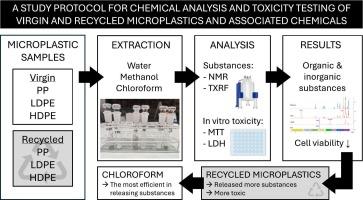原始和回收微塑料及相关化学品的化学分析和毒性测试研究方案
IF 8
1区 环境科学与生态学
Q1 ENVIRONMENTAL SCIENCES
引用次数: 0
摘要
塑料可以含有各种不同的化学物质,这些化学物质要么是有意添加的(IAS),要么是无意添加的(NIAS)。再生塑料尤其可能含有NIAS,其数量和特性可能各不相同,可能会影响塑料的适用性。由于塑料最终可以降解为微塑料,这些物质可以释放到环境中,一旦人类接触到,就会对人类健康构成威胁。因此,需要简单的方法来全面监测这些化学物质,以保证塑料的安全使用。本研究的目的是建立分析和毒性测试的方法存在于二次微塑料的原始和再生来源。在此基础上,以水、甲醇、氯仿为溶剂,提取了原聚丙烯(PP)、再生聚丙烯(PP)、低密度聚乙烯(LDPE)、高密度聚乙烯(HDPE)微塑料的化合物,并利用核磁共振(NMR)和全反射x射线荧光(TXRF)方法对提取物进行了分析。此外,采用两种细胞毒性试验研究了氯仿提取的原生和再生微塑料对人腺癌Caco-2细胞的毒性。结合核磁共振和TXRF方法,对释放的化学物质进行了广泛的分析,表明氯仿是最有效的萃取溶剂。结果表明,与从原始塑料中研磨的微塑料相比,由机械回收塑料研磨的微塑料释放出更多的有机化合物和无机元素。此外,氯仿提取的微塑料对细胞活力的影响呈剂量依赖性,回收的微塑料对细胞活力的影响更为明显。综上所述,这些结果表明,化学物质容易在再生塑料中积累,因此,需要对这些化学物质进行监测,以保证再生塑料的安全使用。本研究表明,氯仿提取能有效地释放塑料中积累的物质,用于化学分析和毒性试验。本文章由计算机程序翻译,如有差异,请以英文原文为准。

A study protocol for chemical analysis and toxicity testing of virgin and recycled microplastics and associated chemicals
Plastics can contain a variety of different chemicals, which are either intentionally (IAS) or non-intentionally (NIAS) added substances. Recycled plastics can contain especially NIAS, which might vary in amount and characteristics, possibly compromising the applicability of the plastics. As plastics can eventually degrade into microplastics, these substances can be released into their environment and upon human exposure, pose a threat to human health. Therefore, simple methods for the comprehensive monitoring of these chemicals are needed to guarantee the safe use of plastics. The purpose of this study was to set up methods for analyzing and toxicity testing of chemicals present in secondary microplastics of virgin and recycled origin. Accordingly, the chemical compounds of virgin and recycled polypropylene (PP), low-density polyethylene (LDPE), and high-density polyethylene (HDPE) microplastics were extracted using water, methanol, and chloroform as solvents, and the extracts were analyzed with nuclear magnetic resonance (NMR) and total reflection X-ray fluorescence (TXRF) methods. In addition, two cytotoxicity assays were applied to study the toxicity of the chloroform extracted virgin and recycled microplastics in human adenocarcinoma Caco-2 cells. The combination of NMR and TXRF methods allowed extensive analysis of the released chemicals showing that chloroform was the most efficient solvent for extraction. The results showed that microplastics milled from mechanically recycled plastics released more organic compounds and inorganic elements compared to microplastics milled from virgin plastics. In addition, the chloroform extracted microplastics decreased cell viability dose dependently and the observed effect was more prominent with the recycled microplastics compared to their virgin counterparts. In conclusion, these results suggest that chemicals tend to accumulate in recycled plastics, and therefore, these chemicals need to be monitored to guarantee the safe use of recycled plastics. This study showed that chloroform extraction is efficient in releasing substances accumulated in plastics for chemical analysis and toxicity testing.
求助全文
通过发布文献求助,成功后即可免费获取论文全文。
去求助
来源期刊

Science of the Total Environment
环境科学-环境科学
CiteScore
17.60
自引率
10.20%
发文量
8726
审稿时长
2.4 months
期刊介绍:
The Science of the Total Environment is an international journal dedicated to scientific research on the environment and its interaction with humanity. It covers a wide range of disciplines and seeks to publish innovative, hypothesis-driven, and impactful research that explores the entire environment, including the atmosphere, lithosphere, hydrosphere, biosphere, and anthroposphere.
The journal's updated Aims & Scope emphasizes the importance of interdisciplinary environmental research with broad impact. Priority is given to studies that advance fundamental understanding and explore the interconnectedness of multiple environmental spheres. Field studies are preferred, while laboratory experiments must demonstrate significant methodological advancements or mechanistic insights with direct relevance to the environment.
 求助内容:
求助内容: 应助结果提醒方式:
应助结果提醒方式:


